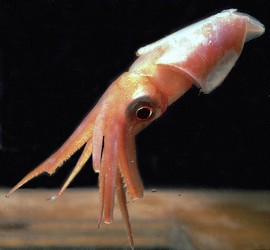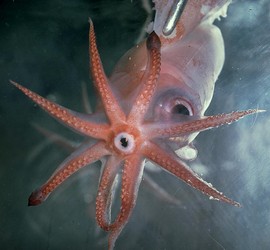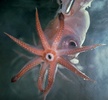Octopoteuthidae
Richard E. Young and Michael Vecchione


This tree diagram shows the relationships between several groups of organisms.
The root of the current tree connects the organisms featured in this tree to their containing group and the rest of the Tree of Life. The basal branching point in the tree represents the ancestor of the other groups in the tree. This ancestor diversified over time into several descendent subgroups, which are represented as internal nodes and terminal taxa to the right.

You can click on the root to travel down the Tree of Life all the way to the root of all Life, and you can click on the names of descendent subgroups to travel up the Tree of Life all the way to individual species.
For more information on ToL tree formatting, please see Interpreting the Tree or Classification. To learn more about phylogenetic trees, please visit our Phylogenetic Biology pages.
close boxIntroduction
Some octopoteuthids reach a large size (160 cm ML); all have a distinctive appearance and are not easily confused with any other squids. Tentacles do not grow much beyond the paralarval stage. They are lost in subadult Octopoteuthis and form only minute appendages in subadult Taningia. The mantle is broad and weakly muscled; large muscular fins apparently provide most of the force for swimming. The short arms carry two series of hooks except near the tips where they are replaced by two series of suckers. Some or all arms terminate in photophores. Arm tips of Octopoteuthis are frequently lost during capture.
Brief diagnosis:
A member of the lepidoteuthid families ...
- without tentacles (rudiments present in some subadults).
- with hooks in two series over most of arm.
- without dermal cushions on mantle.
Characteristics
- Arms
- Arms with hooks in two series, replaced by suckers in two series near arm tips.
- Arms with hooks in two series, replaced by suckers in two series near arm tips.
- Tentacles
- Tentacles reduced or absent in subadults and absent in adults.
- Tentacles reduced or absent in subadults and absent in adults.
- Fins
- Fins large, broad, muscular; fused to one another along dorsal mantle midline.
- Fin length nearly equals mantle length.
Nomenclature
A list of all nominal genera and species in the Octopoteuthidae can be found here. The list includes the current status and type species of all genera, and the current status, type repository and type locality of all species and all pertinent references.
Life History
Mature males lack a hectocotylus but have a large penis that, apparently, can extend well beyond the mantle opening.References
Roper, C. F. E. and M. Vecchione. 1993. A geographic and taxonomic review of Taningia danae Joubin, 1931 (Cephalopoda: Octopoteuthidae), with new records and observations on bioluminescence. P. 441-456. In:: T. Okutani, R. K. O'Dor and T. Kubodera (eds.). The Recent Advances in Cephalopod Fishery Biology. Tokai University Press. Tokyo.
Title Illustrations

| Scientific Name | Octopoteuthis deletron |
|---|---|
| Location | off Hawaii |
| Specimen Condition | Live Specimen |
| Life Cycle Stage | subadult |
| View | lateral |
| Image Use |
 This media file is licensed under the Creative Commons Attribution-NonCommercial License - Version 3.0. This media file is licensed under the Creative Commons Attribution-NonCommercial License - Version 3.0.
|
| Copyright |
© 1996
Richard E. Young

|
| Scientific Name | Taningia danae |
|---|---|
| Location | off Hawaii |
| Life Cycle Stage | subadult |
| View | oral |
| Image Use |
 This media file is licensed under the Creative Commons Attribution-NonCommercial License - Version 3.0. This media file is licensed under the Creative Commons Attribution-NonCommercial License - Version 3.0.
|
| Copyright |
© 1996
Richard E. Young

|
About This Page
Richard E. Young

University of Hawaii, Honolulu, HI, USA
Michael Vecchione

National Museum of Natural History, Washington, D. C. , USA
Page copyright © 2019 Richard E. Young
 Page: Tree of Life
Octopoteuthidae .
Authored by
Richard E. Young and Michael Vecchione.
The TEXT of this page is licensed under the
Creative Commons Attribution-NonCommercial License - Version 3.0. Note that images and other media
featured on this page are each governed by their own license, and they may or may not be available
for reuse. Click on an image or a media link to access the media data window, which provides the
relevant licensing information. For the general terms and conditions of ToL material reuse and
redistribution, please see the Tree of Life Copyright
Policies.
Page: Tree of Life
Octopoteuthidae .
Authored by
Richard E. Young and Michael Vecchione.
The TEXT of this page is licensed under the
Creative Commons Attribution-NonCommercial License - Version 3.0. Note that images and other media
featured on this page are each governed by their own license, and they may or may not be available
for reuse. Click on an image or a media link to access the media data window, which provides the
relevant licensing information. For the general terms and conditions of ToL material reuse and
redistribution, please see the Tree of Life Copyright
Policies.
Citing this page:
Young, Richard E. and Michael Vecchione. 1996. Octopoteuthidae . Version 01 January 1996. http://tolweb.org/Octopoteuthidae/19834/1996.01.01 in The Tree of Life Web Project, http://tolweb.org/










 Go to quick links
Go to quick search
Go to navigation for this section of the ToL site
Go to detailed links for the ToL site
Go to quick links
Go to quick search
Go to navigation for this section of the ToL site
Go to detailed links for the ToL site